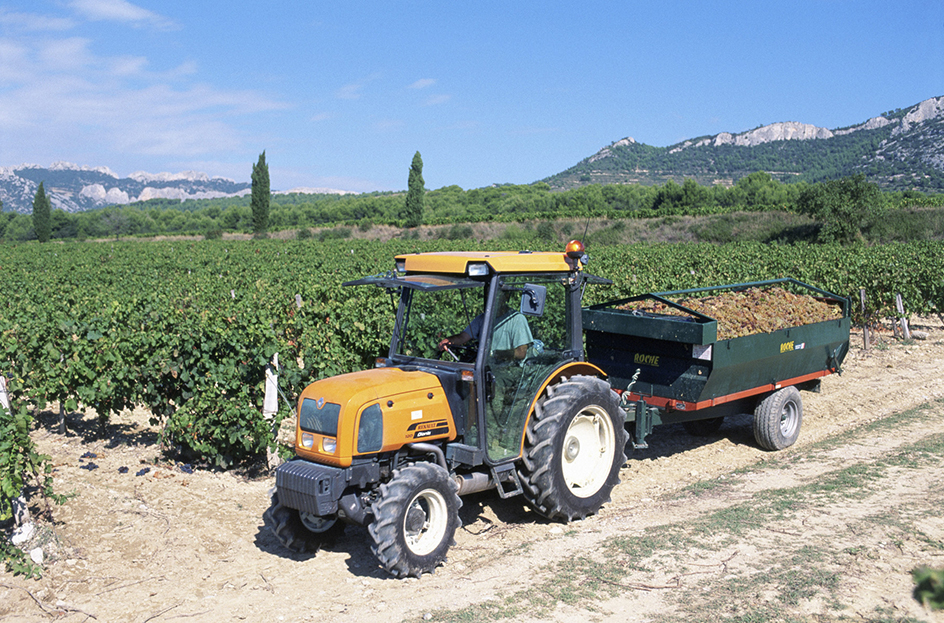Tractor is a machine that pulls or pushes a tool or a machine over land. Tractors provide the chief source of power on most farms. They are also used for industrial and military purposes, for logging, highway construction, and snow clearance. Tractors have either gasoline or diesel engines (see Gasoline engine ; Diesel engine ).

Parts of a tractor.
The modern tractor has several built-in features that enable it to provide power for other farm equipment. These features include the drawbar, a hydraulic system, and a power take-off.
The drawbar
is a device for fastening equipment to the tractor for pulling. The drawbar enables a tractor to pull such equipment as plows, wagons, harrows, combines, and hay balers.
The hydraulic system
controls the working position of implements hitched to or mounted onto the tractor. An engine-driven hydraulic pump and cylinder provide power to raise and lower these implements. Many rear-wheel-drive tractors have hydraulic systems with a mechanism that shifts weight from the front to the rear wheels of the tractor. The weight shift increases traction for pulling mounted implements.
The power take-off,
or PTO, provides power for machines that are either mounted on or pulled by the tractor. The coupling device between the PTO and the equipment usually consists of two universal joints, one on each end of a telescoping shaft. The flexible action of the joints and the telescoping action of the shaft allows sharp turning and movement over rough surfaces without harming the power system. The PTO drives the moving parts of mowing machines, harvesters, hay balers, combines, potato diggers, and spray pumps.
Types of tractors.
There are two major types of tractors: the wheel tractor and the tracklayer tractor, known as a crawler.
Wheel tractors
make up the majority of farm tractors. Many farmers use an all-purpose tractor because it does a variety of jobs, such as planting, cultivating, and harvesting. It has high rear wheels. It has either one or two small front wheels placed close together or two front wheels spaced the same as the rear wheels. The spacing of the wheels enables the tractor to be driven between rows of crops. Wheel tractors may have either two-wheel or four-wheel drive. Two-wheel-drive models range in weight from about 3,000 pounds (1,400 kilograms) to more than 20,000 pounds (9,000 kilograms). Four-wheel-drive tractors may weigh as much as 60,000 pounds (27,000 kilograms). The demand for larger tractors has increased as the average size of farms has increased.
Crawler tractors,
also called track tractors, are driven on two endless tracks. They are steered by stopping or slowing one of the tracks. Crawler tractors are used for heavy jobs, for land clearing, and for work on soft or rugged land. The smallest crawlers weigh about 3,800 pounds (1,720 kilograms). The largest of these tractors weigh more than 70,000 pounds (32,000 kilograms).
History.
Tractors were first used during the 1870’s. These tractors, called traction engines, were large, four-wheeled machines driven by steam. They provided enough power to pull as many as 40 plows, but they were too awkward to be practical. Smaller machines with internal-combustion engines soon replaced them. But the new machine had only a kerosene engine mounted on a four-wheeled frame. Later, kerosene or gasoline engines were built as part of the tractor frame. The tractors could do almost all the field work, but were too low to pull a cultivator through tall crops. Then, in the 1920’s, the all-purpose tractor was developed.
Early manufacturing companies usually made only one tractor model or size. But modern companies make a complete line. Modern tractors have both speed and power, and are easy to operate. Most have power steering and power brakes. Many also have enclosed cabs with heating and air-conditioning systems and special structures that protect the operator if the tractor accidentally turns over.
